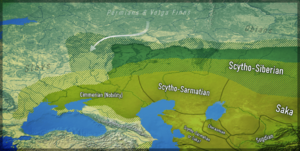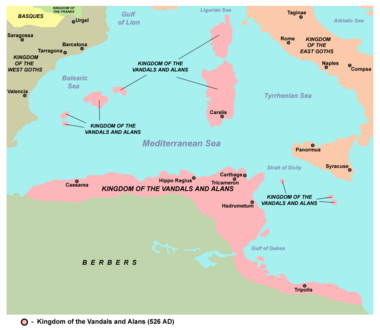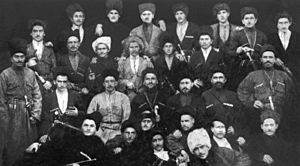Alans facts for kids
| Alani | |
|---|---|
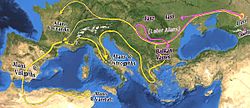
Map showing the migrations of the Alans
|
|
| Languages | |
| Scythian, Alanian | |
| Related ethnic groups | |
| Ossetians |
The Alans (Latin: Alani) were an ancient group of people from the North Caucasus region. They were Iranian nomads, meaning they moved around a lot and raised animals. Many historians believe they were part of the Sarmatians, another nomadic group. Some also think they might be connected to the Massagetae.
Historians link the Alans to the Central Asian Yancai from Chinese writings. They are also connected to the Aorsi from Roman records. The Alans moved west and became powerful among the Sarmatians in the Pontic–Caspian steppe. Roman writings mention them in the 1st century CE. At that time, they lived north of the Black Sea. They often attacked the Parthian Empire and Roman areas in the Caucasus.
Around 375 CE, after the Huns defeated the Goths, many Alans moved west. They crossed the Rhine River in 406 CE with the Vandals and Suebi. They settled in places like Orléans and Valence. Around 409 CE, they crossed the Pyrenees mountains into the Iberian Peninsula (modern Spain and Portugal). They settled in areas like Lusitania.
The Alans in Iberia were defeated by the Visigoths in 418 CE. They then joined the Hasdingi Vandals. In 428 CE, the Vandals and Alans crossed into North Africa. There, they created a kingdom. This kingdom lasted until the Byzantine Emperor Justinian I conquered it in 534 CE.
Some Alans stayed under Hunnic rule. They later formed the strong kingdom of Alania in the North Caucasus in the 9th century. This kingdom lasted until the Mongol invasions in the 13th century CE. Many scholars believe these Alans are the ancestors of the modern Ossetians.
The Alans spoke an Eastern Iranian language. This language came from Scytho-Sarmatian and later became the modern Ossetian language. The name Alan comes from an Iranian word for Aryan.
What's in a Name?
The Alans were known by similar names in different languages from the 1st century CE. These names include:
- Latin: Alānī
- Greek: Alanoi
- Chinese: Alanliao (in the 2nd century) and Alan (in the 3rd century)
- Parthian and Middle Persian: Alānān
- Arabic: Alān
- Syriac: Alānayē
- Armenian: Alank'
- Georgian: Alaneti (meaning 'country of the Alans')
- Hebrew: Alan
The name is also found in the modern Ossetian language as Allon.
The name Alān is a different way of saying the Old Iranian word *Aryāna. This word comes from arya-, which means 'Aryan'. This was a common way for Indo-Iranian peoples to describe themselves. The name probably helped unite different tribes by reminding them of a shared 'Aryan' background.
Other group names also include 'Alan'. For example, the Rhoxolāni means 'Bright Alans'. The Alanorsoi means 'White Alans'. The common names Alan and Alain might have come from Alan settlers in Western Europe.
The Alans were also known by other names like Asi, As, and Os. These names are the root of the modern name Ossetian.
History of the Alans
Important Dates

Where the Alans Came From
The Alans were formed when the Massagetae, a nomadic Iranian group from Central Asia, joined with some older tribes. They were related to the Asii who had invaded Bactria. The Kang-chü people pushed the Alans west. The Kang-chü lived near the Syr Darya river and expanded their rule.
Early Alan History
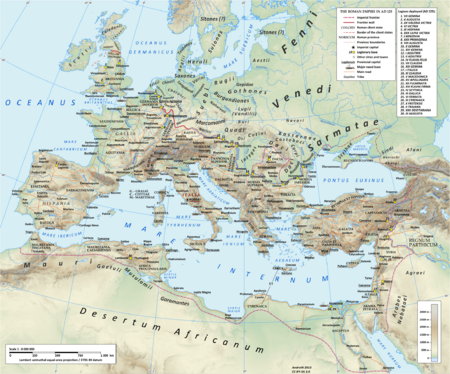
The first mentions of the Alans appear around the same time in texts from the Mediterranean, Middle East, and China. In the 1st century CE, the Alans moved west from Central Asia. They became very powerful among the Sarmatians living between the Don River and the Caspian Sea.
The Alans are mentioned in an inscription about Vologases I, a Parthian king. It says he fought Kuluk, king of the Alani, in 62 CE. The Jewish historian Josephus also wrote about the Alans. He reported that Alans living near the Sea of Azov crossed the Iron Gates in 72 CE to raid. They defeated the armies of Pacorus and Tiridates, who were brothers of Vologeses I.
Josephus wrote:
There was a nation of the Alans, who were Scythians, living near Tanais and Lake Maeotis. They planned to attack Media and other areas to steal things. They made a deal with the king of Hyrcania, who controlled the passage that King Alexander had closed with iron gates. This king let them through. So, many Alans came and surprised the Medes, stealing their goods and many animals. Nobody dared to fight them. Pacorus, the king of Media, ran away to a safe place. He barely saved his wife and concubines by paying a hundred talents for their freedom. The Alans then stole from the country easily and went as far as Armenia, destroying everything. Tiridates, the king of Armenia, met them and fought. He was lucky not to be captured alive. A man threw a rope over him, but he cut it with his sword and escaped. The Alans were even angrier after this. They destroyed the land and took many people and much loot from both kingdoms back to their own country.
The Alans attacking Parthia through Hyrcania shows that many Alans were still living northeast of the Caspian Sea. By the early 2nd century CE, the Alans controlled the Lower Volga and Kuban regions. These lands were once held by the Aorsi and the Siraces. The Alans likely took them over, as these groups are no longer mentioned. The Alans' influence probably spread further west, covering most of the Sarmatian world.
In 135 CE, the Alans launched a huge raid into Asia Minor through the Caucasus. They destroyed Media and Armenia. Arrian, the Roman governor of Cappadocia, eventually drove them back. Arrian wrote a detailed report called 'War Against the Alans', which helps us understand Roman military tactics.
From 215 to 250 CE, the Germanic Goths moved southeast. They broke the Alans' power on the Pontic Steppe. However, the Alans seem to have greatly influenced the Goths. The Goths became excellent horsemen and adopted the Alanic animal style art.
After the Goths arrived on the steppe, many Alans moved east towards the Don River. There, they likely met the Huns. The historian Ammianus wrote that the Alans were "somewhat like the Huns, but less wild in their life and habits." Another historian, Jordanes, said the Alans "were their equals in battle, but different in their culture and looks."
The 4th-century Roman historian Ammianus Marcellinus noted that the Alans were "formerly called Massagetae." Dio Cassius also wrote that "they are Massagetae." It is likely that the Alans were a mix of different Iranian peoples, including Sarmatians, Massagetae, and Sakas.
Alans in Gaul
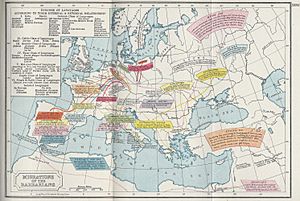
Around 370 CE, the peaceful relationship between the Alans and Huns ended. The Huns attacked the Don Alans, killing many and forming an alliance with the survivors. These Alans then successfully invaded the Goths in 375 CE with the Huns. They later joined the Huns in their move west.
After the Hunnic invasion in 370 CE, other Alans and Sarmatians moved west. One Alan group fought with the Goths in the important Battle of Adrianople in 378 CE. In this battle, the Emperor Valens was killed. As the Roman Empire weakened, the Alans split into different groups. Some fought for the Romans, while others joined the Huns, Visigoths, or Ostrogoths.
A part of the western Alans joined the Vandals and the Suebi in their invasion of Roman Gaul. Gregory of Tours wrote that the Alan king Respendial helped the Vandals in a fight with the Franks. This happened when they crossed the Rhine River on December 31, 406 CE. Gregory also said that another Alan group, led by Goar, crossed the Rhine at the same time. But they immediately joined the Romans and settled in Gaul.
Under Goar, the Alans allied with the Burgundians. They helped make Jovinus an emperor. Goar's successor, Sangiban, and the Alans of Orléans played a key role in stopping Attila the Hun at the Battle of Châlons. In 463 CE, the Alans defeated the Goths at the Battle of Orléans. They later defeated the Franks led by Childeric I in 466 CE.
Around 502–503 CE, Clovis I attacked Armorica but was defeated by the Alans. However, the Alans were Chalcedonian Christians, like Clovis. They wanted good relations with him to balance the hostile Arian Visigoths. So, they made a deal. Clovis came to rule the people of Armorica, and their military strength joined the Merovingian army.
Alans in Hispania and Africa
In 409 CE, the Alans, led by Respendial, followed the Vandals and Suebi into the Iberian peninsula (modern Portugal and Spain). They settled in the areas of Lusitania and Carthaginensis. The Kingdom of the Alans was one of the first Barbarian kingdoms to be formed.
In 418 CE, the Alan king, Attaces, was killed fighting the Visigoths. This group of Alans then asked the Vandal king Gunderic to become their king. The separate identity of Respendial's Alans disappeared. While some Alans stayed in Iberia, most went to North Africa with the Vandals in 429 CE. Later, the rulers of the Vandal Kingdom in North Africa called themselves Rex Wandalorum et Alanorum ("King of the Vandals and Alans").
There are still some signs of the Alans in Portugal. For example, the town of Alenquer might mean "Temple of the Alans." Its castle might have been built by them, and the Alaunt dog is still on the city's coat of arms. They also helped build the castles of Torres Vedras and Almourol.
In the Iberian peninsula, the Alans were known for their large hunting and fighting dogs. These were mastiff-type dogs called the Alaunt. They likely brought these dogs to Europe. The original breed is gone, but its name lives on in a Spanish dog breed called Alano. This dog is still used for hunting boar and herding cattle.
Medieval Alania
The Alans who stayed in their original home north of the Caucasus mountains met and fought with the Bulgars, Gökturks, and Khazars. These groups pushed most of the Alans from the plains into the mountains.
The Alans became Byzantine Orthodox Christians in the early 10th century. Some reports say they stopped being Christian in 932 CE, but this didn't last long. By the 13th century, the Alans in the Caucasus were known as Byzantine-rite Christians. These Caucasian Alans were the ancestors of the modern Ossetians. Their name Ossetian comes from Ās, which was probably the ancient Aorsi.
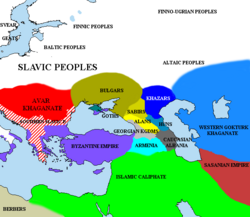
Some other Alans remained under Hunnic rule. The eastern Alans were spread across the steppes until the late Middle Ages. The Mongols forced them into the Caucasus, where they became the Ossetians. Between the 9th and 12th centuries, they formed alliances that grew into the Christian kingdom of Alania. Most Alans submitted to the Mongol Empire between 1239 and 1277. They took part in Mongol invasions of Europe and China.
In 1253, the friar William of Rubruck reported many Europeans in Central Asia. It is known that 30,000 Alans formed the royal guard (Asud) for the Yuan court in Dadu (Beijing). Marco Polo later wrote about their role in the Yuan dynasty. These Alans are thought to have contributed to a modern Mongol clan called Asud. John of Montecorvino, an archbishop in Dadu, reportedly converted many Alans to Roman Catholic Christianity.
A missionary named Pian de Carpine said that some Alans successfully fought off a Mongol siege on a mountain for 12 years:
When they (the Mongols) begin to besiege a fortress, they besiege it for many years, as it happens today with one mountain in the land of the Alans. We believe they have been besieging it for twelve years and they (the Alans) put up courageous resistance and killed many Tatars, including many noble ones.
The Mongols used a "divide and conquer" tactic against the Alans and the Cumans (Kipchaks). They first told the Cumans to stop helping the Alans. After the Cumans agreed, the Mongols then attacked the Cumans after defeating the Alans. Alans were also recruited into the Mongol army. One unit was called the "Right Alan Guard."
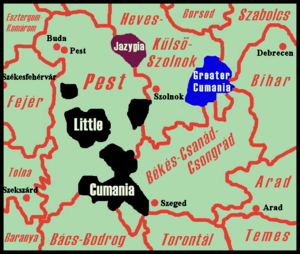
It is thought that some Alans moved north and mixed with other groups, eventually becoming Volga Tatars. A group of Alans called the Iasi founded a town in northeast Romania around 1200–1300. This town, called Iași, later became the capital of Moldavia.
Modern Descendants
The descendants of the Alans live in parts of Russia and Georgia. They speak the Ossetian language. This language belongs to the Northeastern Iranian language group. It is the only remaining part of the Scytho-Sarmatian language family, which once covered much of the Pontic steppe and Central Asia.
Modern Ossetian has two main dialects: Digor, spoken in western North Ossetia, and Iron, spoken in the rest of Ossetia. A third branch, Jassic (Jász), was once spoken in Hungary. The written language, based on the Iron dialect, was set by the national poet, Kosta Khetagurov (1859–1906).
What the Alans Looked Like
The Roman historian Ammianus Marcellinus wrote about the Alans in the 4th century:
Nearly all the Alani are men of great stature and beauty; their hair is somewhat yellow, their eyes are terribly fierce.
Alan Genetics
A 2014 study looked at bone fragments from 10 Alanic burials near the Don River. DNA was found in seven of them. Four belonged to yDNA Haplogroup G2, and six had mtDNA I. This suggests that the tested individuals might have been from the same tribe or even closely related. This also supports the idea that Ossetians are direct descendants of the Alans, as Haplogroup G2 is common among Ossetians.
In 2015, research on Sarmatian-Alan burials showed that two Alan samples from the 4th to 6th century CE had yDNAs G2a-P15 and R1a-z94.
A genetic study in 2018 looked at the remains of six Alans buried in the Caucasus from about 100 CE to 1400 CE. The Y-DNA samples included haplogroup R1 and haplogroup Q-M242. One Q-M242 sample from Beslan, North Ossetia (200 CE) had four relatives among Chechens. The mtDNA samples included HV2a1, U4d3, X2f, H13a2c, H5, and W1.
Alan Language
The ancient language of the Alans was an Eastern Iranian dialect. It was either the same as, or very similar to, other ancient Eastern Iranian languages. We can see this by comparing the word for "horse" in different Indo-Iranian languages and the reconstructed Alanic word for horse:
| Language | Affiliation | Horse |
|---|---|---|
| Alanic | *aspa | |
| Lithuanian | Baltic | ašvà |
| Sanskrit | Indo-Aryan | áśva |
| Khotanese | Northeastern Iranian | aśśa |
| Ossetian | Northeastern Iranian | efs |
| Wakhi | Northeastern Iranian | yaš |
| Yaghnobi | Northeastern Iranian | asp |
| Avestan | Southeastern Iranian | aspa |
| Balochi | Northwestern Iranian | asp |
| Kurdî | Northwestern Iranian | asp,hesp,hasp |
| Median | Northwestern Iranian | aspa |
| Old Persian | Southwestern Iranian | asa |
| Middle Persian | Southwestern Iranian | asp |
| Persian | Southwestern Iranian | asb |
Alan Religion
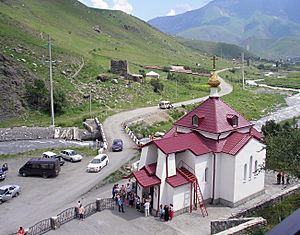
Before they became Christians, the Alans believed in many gods (polytheists). Their religion was either the Scythian religion or a form of Zoroastrianism. Some of their traditions came directly from the Scythians, like special rituals for their main god.
In the 4th and 5th centuries, Byzantine missionaries from the Arian church partly converted the Alans to Christianity. In the 13th century, the Mongol invasions pushed the eastern Alans further south into the Caucasus. There, they mixed with local groups and formed three different communities. Around 1395, Timur's army invaded the Northern Caucasus and killed many Alans.
Over time, the Digor in the west were influenced by the Kabard people and Islamic faith. Islam was brought to the region in the 17th century through the Kabardians. After 1767, all of Alania came under Russian rule. This greatly strengthened Orthodox Christianity in the area. A small group of today's Ossetians follow the traditional Ossetian religion, which was revived in the 1980s as Assianism (Ossetian: Uatsdin = 'true faith').
|
See also
 In Spanish: Alanos para niños
In Spanish: Alanos para niños
- Roxolani, possibly a sub-set of the Alans
- List of ancient Iranian peoples


